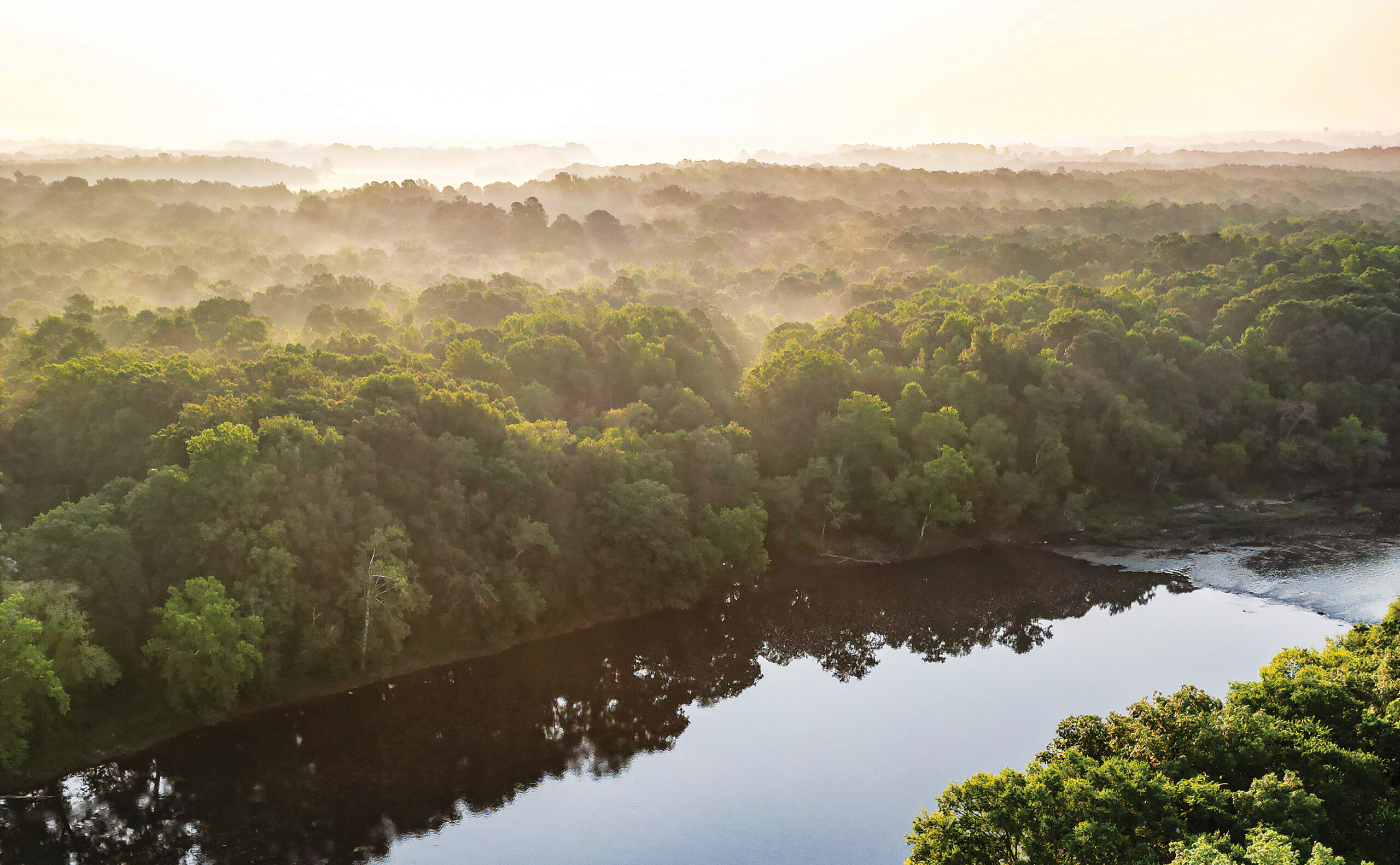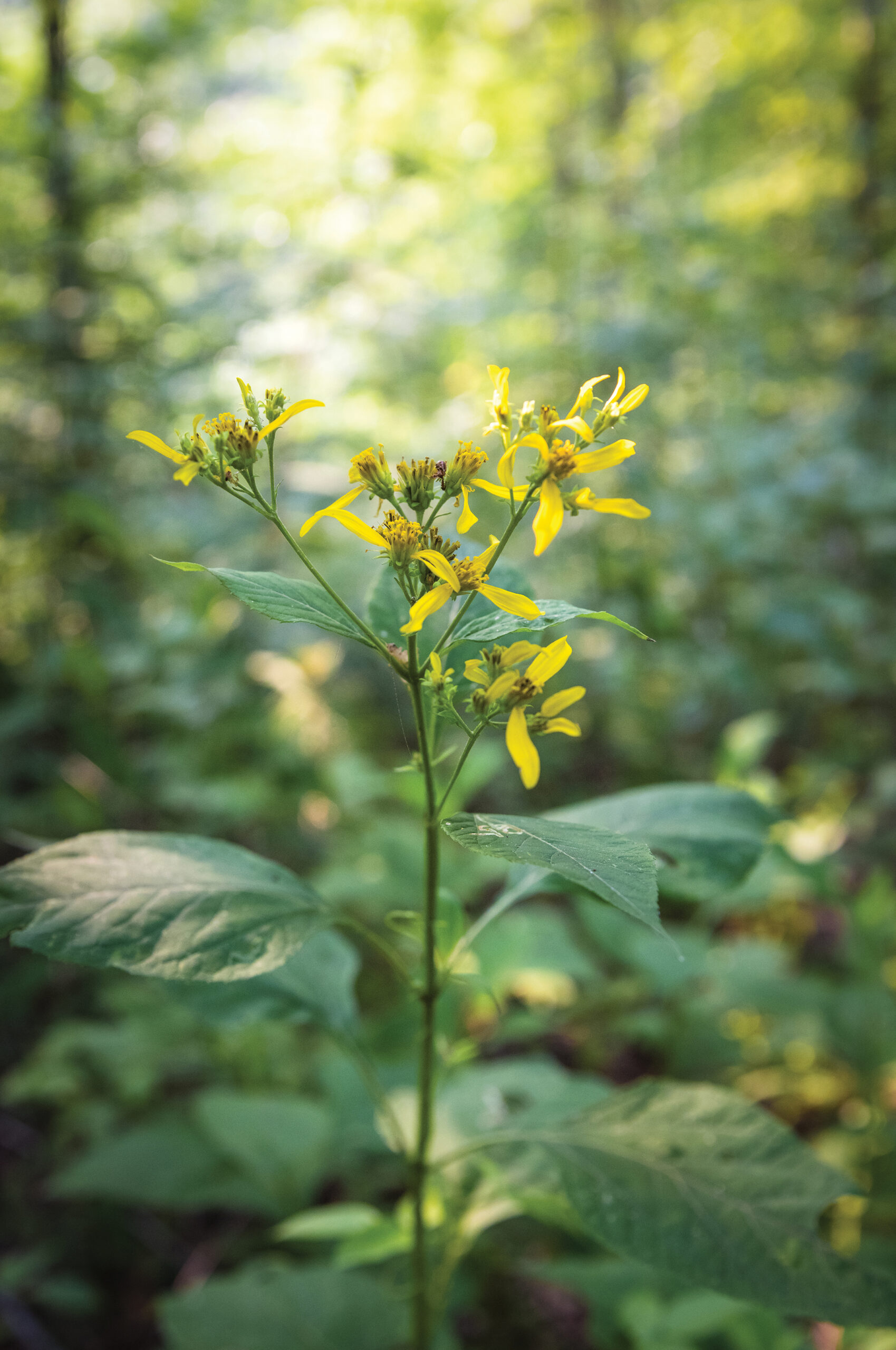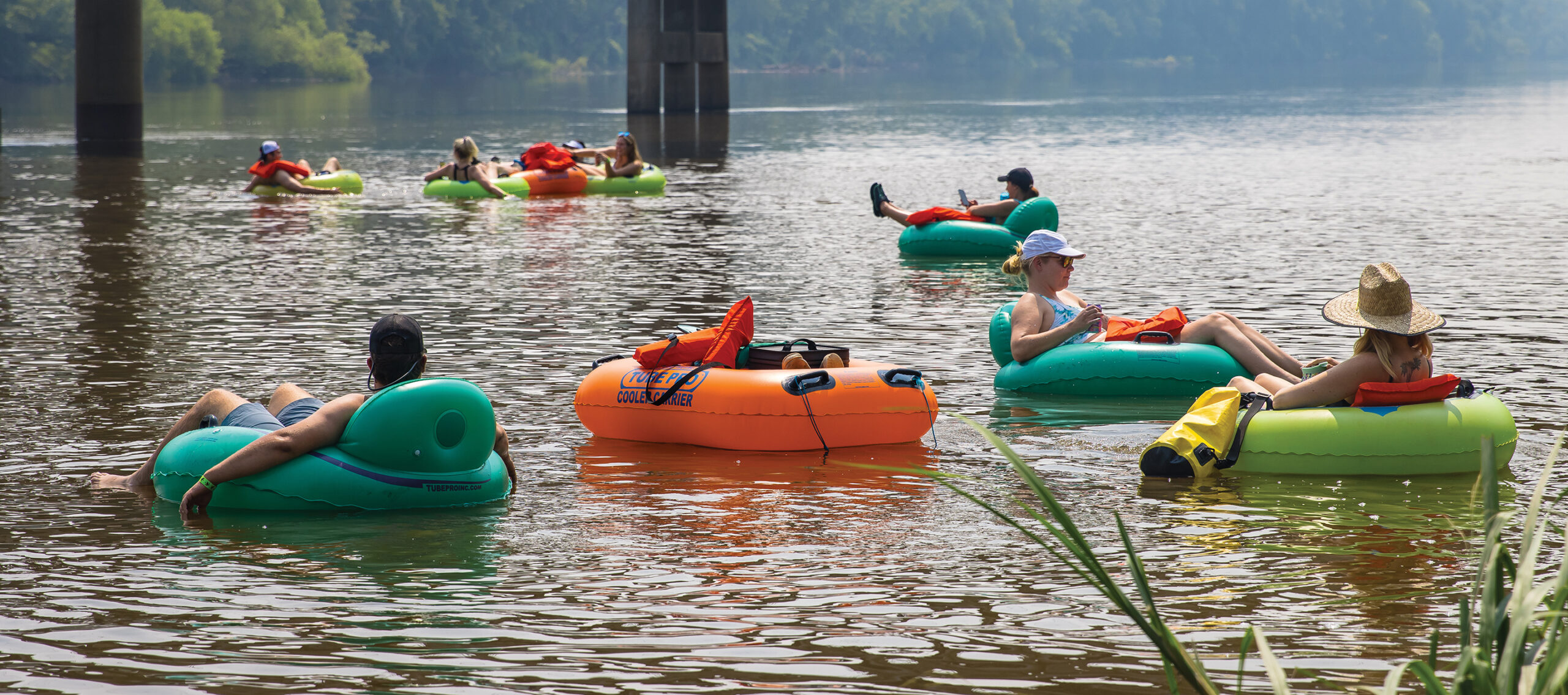The Cape Fear River has provided for Campbell University for over a century. A biology professor is leading efforts to give back and preserve the area’s natural beauty.
Story by Billy Liggett
Photography by Catrina Moretz
Drone photography by Evan Budrovich
A product of the post-Civil War Industrial Revolution, this portable sawmill was considered a state-of-the-art piece of machinery, and it arrived in one piece by boat along the nearly 200-mile trek up the Cape Fear River from Wilmington to Chatham County on Friday, March 1, 1901.

The mill’s owner, tired from the day-long journey upstream, decided to not unload his new purchase that night and instead opted to worry about it the following Monday. He was unaware of the massive storm heading his way that would dump about three inches of rain overnight — enough to raise the river and send his unmanned boat and his mill back toward the Atlantic Ocean.
It wouldn’t make it that far.
Just 30 miles away in the small community of Buies Creek, an engineer named Zachary Taylor Kivett faced a similar dilemma from that same storm. Kivett was two months into building what would become Kivett Hall — a towering structure made of wood and brick designed to replace the buildings destroyed in a massive fire on the campus of Buies Creek Academy the previous December. But the hand-pulled ferry he used to cross the Cape Fear from his home to the job site had also washed away in the storm.
Kivett was standing on the river’s edge with his sons and a few student workers debating how they would get to work that day when the floating sawmill — a gift that could only have come from the heavens — came into view.
“They lassoed it, pulled it in and tied it up,” wrote Everett McNeill Kivett, a Z.T. Kivett descendant and author of The McNeill’s Ferry Chronicle. “When the river went down, they brought that sawmill on over and sawed the lumber. Then after they sawed the lumber, they used the engine … and burned the brick.”
Kivett viewed the sawmill as divine intervention. But he also knew it belonged to somebody. When the owner was discovered, Kivett convinced him that the storm was an act of God to “help build Mr. Campbell’s school,” the owner agreed to sell the machine for $50.
When the Cape Fear delivered a miracle in 1901, it did more than ensure and expedite the construction of a building that would serve as an iconic symbol for the fledgling academy and future university. It kept alive the vision of J.A. Campbell to provide an education to the young men and women in his rural community. For 136 years, the Cape Fear has remained a vital resource for the school —a living research laboratory and a driver of nature and humanity.
“Like the land through which the Cape Fear runs, the river continues to shape us and tell our story.”
— Campbell University President J. Bradley Creed

Queen Anne’s lace. Texas lilacs. Yellow crownbeards. Black-eyed Susans. Asters and goldenrods. Purple coneflowers. Rose of Sharons. Butterfly bushes.
They’re but a few of the flowers spotted and named by Dr. John Bartlett, associate professor of biology at Campbell University. He points them out during a tour of his pride and joy, the Pollinator Trail, which occupies 370 acres between U.S. 421 and the Cape Fear River, next to the Keith Hills community and golf course.

Over a century since the Kivett miracle, the river continues to serve Campbell University. For Bartlett — who teaches courses in biology, ecology, zoology, ornithology and vertebrate natural history — the Cape Fear and the nature that surrounds it is like an enormous outdoor laboratory. And he and his students have become more than teachers and learners; they’ve become caretakers of this lab — in particular, the 370 acres of meadows, forest and winding trails that connect Campbell students with the shores of the river.
“It’s a wonderful teaching space,” says Bartlett, a former research scientist for the USDA Forest Service now in his 22nd year at Campbell. “I’m a huge proponent of learning by experience, and for much of what I teach in the classroom, you have to get out here to see it to really understand what you’re learning. I’ve had students from larger cities who’ve never seen areas like this — they’d never stepped off an asphalt path before and were terrified of being out in nature. But after a few weeks, they own the space. They fall in love with it.”
Science classes aren’t the only groups occupying the space. ROTC students can be found using the trails and meadows for training purposes. Campbell’s cross country team has found a perfect track with rolling hills and scenic views for their training. There’s history all around. Inspiration can be found for artists, writers and musicians.
Twelve years ago, the only Campbell students using this land were carrying golf bags instead of backpacks. Keith Hills Golf Course, owned and operated by Campbell University and occupied by Campbell Athletics’ golf teams, did away with the “back nine” of its 36-hole course in part to make way for a new health sciences campus, which today includes the Leon Levine Hall of Medical Sciences and the Tracey F. Smith Hall of Nursing and Health Sciences. Construction of those buildings was completed in 2013 and 2016 respectively, and their addition left an additional 370 acres of unused land to the west.

Even when it was a golf course, Bartlett was bringing his classes out there to study the native plants and wildlife surrounding the freshly mowed fairways and manicured greens. But with the land no longer needing intense landscaping, Bartlett saw an opportunity.
“There were people who said this was originally the most beautiful, remote part of the golf course,” he says. “Now, it’s returning to a natural habitat.”
A little known fact — those feeling nostalgic for the old Baldwin and Kitchin residence halls that stood where the Oscar N. Harris Student Union is found today can visit the far western side of the back nine to see what’s left of those buildings. After their demolition in 2017, the concrete and brick was crushed to pebble-sized rocks and used to grade a long strip along the former golf course. Bartlett and Campbell staff then came in and populated the area with native flowers (brick debris is easy to find near the Club Road entrance to the land).
 As nature took over, the fairways quickly became meadows. Fast-growing sweet gum trees sprouted, and small wooded areas began popping up. It’s common to hear of a forest or other natural habitat being destroyed for residential or business development, but it’s a rare opportunity to oversee a transitional forest. Bartlett took it upon himself to oversee nature’s return — not only would it be a terrific learning opportunity for his students, but the area had recreational potential, too.
As nature took over, the fairways quickly became meadows. Fast-growing sweet gum trees sprouted, and small wooded areas began popping up. It’s common to hear of a forest or other natural habitat being destroyed for residential or business development, but it’s a rare opportunity to oversee a transitional forest. Bartlett took it upon himself to oversee nature’s return — not only would it be a terrific learning opportunity for his students, but the area had recreational potential, too.
Greenways are “in,” and elected officials in Harnett County were once in serious talks to develop a greenway system spanning from Fort Liberty’s military reservation in the southwest portion of the county, north to Raven Rock and southeast along the Cape Fear through Lillington, Buies Creek, Erwin and Dunn.
Bartlett created the Cape Fear River Initiative to manage the area, and soon after, he named the 370 acres, “Campbell Pollinator Meadows and River Park.” He created maps highlighting hiking trails, wildlife viewing areas, camping sites, kayak and canoe landings, fishing areas and even a “Ghosts of the Cape Fear” trail. In 2021, he was named to the board of directors for the Three Rivers Land Trust, a nonprofit organization whose mission is to conserve land, natural areas, rural landscapes, family farms and historical places in North Carolina’s Piedmont and Sandhills regions.
He’s not the first biology professor from Campbell University to take a leadership role in overseeing the creation of a (hopefully one day) beloved natural park. He’s inspired by the former head of Campbell’s biology department from the 1960s through the 80s, Bob Soots, the man called the “primary force” behind the creation of Raven Rock State Park just west of Lillington. While teaching a course on invertebrates’ natural history early in his teaching career, Soots became acquainted with the giant “Raven Rock” formation near the northernmost point of the Cape Fear. He began using the area as his own outdoor lab and soon took an interest in greasing the gears to make the area a public park. He even got the support of Pulitzer Prize-winning playwright (and Buies Creek Academy grad) Paul Green, and in 1969, Raven Rock became a state park.
“I like to think of Bob Soots as my academic grandfather,” Bartlett says. “And, really, the work he put into creating that park was impressive.”
Bartlett met Soots in 2019 before the 50th anniversary of Raven Rock to tell him about plans to honor him and his achievement. Soots died in December of 2022 at the age of 88, and Bartlett says he’s thankful he got to meet him and show his appreciation.
“I felt so blessed to be a part of that event,” he says. “He had a clear vision, and what he did has been an inspiration to me ever since.”

The mountains of Utah were Dr. Michael Larsen’s outdoor nirvana as an undergrad at Utah State University in the 1970s. Larsen was studying environmental science with a concentration in fisheries and wildlife, and the Logan River — a pristine body of water just minutes from the Utah State campus — was Larsen’s lab. Fast forward to the early 80s — after a nine-month assignment with the U.S. Army in the jungles of Ecuador — and Larsen was on the other side of the country earning his master’s degree in ecology from Rutgers University in northern New Jersey, where the rivers and reservoirs were anything but pristine.
In New Jersey — and later in Raleigh while earning his Ph.D. at NC State — Larsen studied water pollution, both its causes and solutions. When he interviewed for a faculty position at Campbell University in 1995, Larsen was intrigued by the school’s proximity to the Cape Fear, which had its own issues with pollution on the southern end near industrial sites around Wilmington and in the middle and upper portions due to runoff from swine and poultry farms.
 At roughly 200 miles long, the Cape Fear is only the 10th longest river in North Carolina (the Neuse, at 275 miles, is the longest river completely within the state, and the 410-mile Roanoke River begins in Virginia). But it is the largest of the four river basins contained entirely in the state, covering 9,300 square miles from north of Durham all the way to Wilmington. Whereas a river is just the one continuously flowing body of water, a basin includes the entire area drained by a river and all of its tributaries.
At roughly 200 miles long, the Cape Fear is only the 10th longest river in North Carolina (the Neuse, at 275 miles, is the longest river completely within the state, and the 410-mile Roanoke River begins in Virginia). But it is the largest of the four river basins contained entirely in the state, covering 9,300 square miles from north of Durham all the way to Wilmington. Whereas a river is just the one continuously flowing body of water, a basin includes the entire area drained by a river and all of its tributaries.
Buies Creek is a tributary of the Cape Fear River. The creek is also a big part of Larsen’s curriculum at Campbell. The back room of the McLamb Environment Sciences Center is a true “mud room” where Larsen stores the boots and hip waders he and his students wear for creek excursions. The work serves dual purposes — his students, like Bartlett’s are “learning by doing” — and much of what Larsen does is aimed at protecting and preserving the area’s natural resources.
“I had one student, Emily Mitter, who’s doing graduate work at Louisiana State University now, where she also plays volleyball, and she did her research project on the pollution levels in the creek that runs from the Cape Fear through Erwin [Juniper Creek], and she presented her findings at the Wiggins Symposium,” Larsen says.
“That area is very urbanized, and the creek’s been negatively impacted. There are biological indicators, like the canary in the coal mine, that tell you if there’s potential toxicity — certain organisms that aren’t present if the water quality is poor. It doesn’t tell you why it’s polluted, but it sets the stage for the next step, such as chemical analysis.”
Larsen’s hope is to get more students involved in this kind of work — possibly partnering more with other departments like chemistry and physics and possibly the School of Engineering — to restore areas like Juniper Creek and portions of the Cape Fear.
At NC State, Larsen worked with a conservation group called the Neuse River Foundation and their riverkeepers (now known as “Sound Rivers”) to keep waterways and natural areas in the Neuse River basin clean.” He points to the work Bartlett is doing with the Cape Fear River Initiative as a step in the right direction locally. The Upper Cape Fear and its watershed, compared to the Wilmington area, is relatively clean, with the notable exception of more recent contamination of parts of the Cape Fear River downstream of Fayetteville, but diligence and research is needed to keep it that way.
Bartlett’s vision for the Campbell Pollinator Meadows and River Park is to have a natural area that everybody can enjoy. Meadows with beautiful plants, strips of cultivated and maintained pollinator flowers to provide ecosystems for ever-important honey bees, inviting sanctuaries for native and migrating birds, inviting trails for joggers and walkers and anybody wishing to experience the Earth’s natural wonders — the seeds have been planted, so to speak, but help is needed to maintain and improve upon what is already there.
In his lifetime, Bartlett would love to see a more formal parking area and entrance for the park. He’d love to see bathrooms and other facilities and perhaps a pavilion for professors and their students to gather under in case a storm comes in. It doesn’t matter that it used to be a golf course and, perhaps, none of this was ever part of the “big plan” from the beginning. It’s here now, and there’s great value in having it, he says.
“My plan is to keep doing what I’m doing,” he says. “You work hard, and you hope that others can see your vision and see what’s happening. And I do think people are starting to see the value of it.”
Lillington
Steady growth for Harnett’s county seat: The Cape Fear River’s northern-most town is also the county seat for Harnett County and a community that’s experienced slow, but steady growth in the last 10 years. Lillington residents enjoy small-town hospitality, convenient location in central North Carolina and access to beautiful natural resoruces like the river and nearby Raven Rock State Park. The Lost Paddle Tavern and Kayak Shop offers kayak and tube rentals and boat access to the river at the U.S. 421 bridge. The shop’s manager Kayla Walvatne says Campbell students are regular customers during “tube season,” and on a busy day, as many as 600 people will come to enjoy the calm waters of the Cape Fear.
Dunn & Erwin
History and nature in one of U.S.’ top micropolitan areas: A fun fact — Erwin, North Carolina, was originally named “Duke, North Carolina” but the name was changed after the formation of the University in Durham to avoid any confusion. The Erwin Cottom Mill, built in 1902, would make the town an important contributor to the U.S. denim industry, becoming one of the top producers of the fabric for the first half of the 20th century. Erwin and its neighbor, the City of Dunn, experienced little growth for decades until recently. Over the last decade the Dunn Micropolitan area is considered one of the fastest-growing micropolitans in the U.S. thanks to its proximity to the booming Triangle area and the bustling I-95 corridor. Dunn and Erwin residents can experience the benefits of business growth while also having access to history and natural beauty. The Cape Fear parallel with both, and in between the Averasboro Battlefield draws thousands of Civil War historians and enthusiasts every year.




